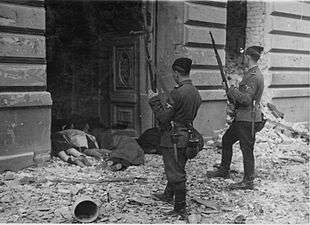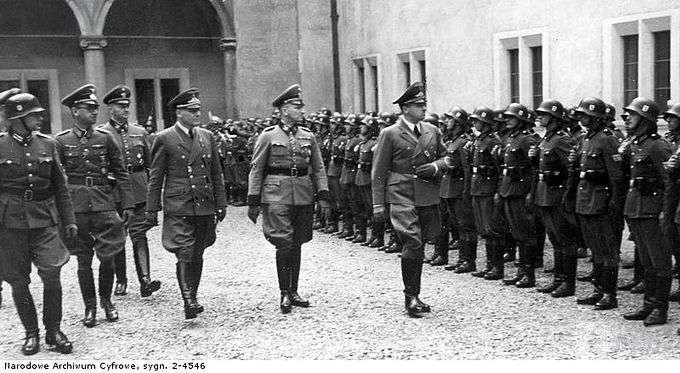Sonderdienst
| Sonderdienst | |
|---|---|
|
Leaders of General Government during inspection of Sonderdienst battalions: from right, Generalgouverneur Hans Frank, Chief of the Police GG Herbert Becker and secretary of state Ernst Boepple | |
| Active | Founded 6 May 1940 |
| Country | Occupied Poland |
| Allegiance |
|
| Type | Paramilitary police reserve |
Sonderdienst (German: Special Services) were the Nazi German paramilitary formations created in semicolonial General Government during the occupation of Poland in World War II. They were based on similar SS formations called Volksdeutscher Selbstschutz operating in the Warthegau district of German-annexed western part of Poland in 1939.[1]
Sonderdienst were founded on 6 May 1940 by Gauleiter Hans Frank who stationed in occupied Kraków.[1] Initially, they were made up of ethnic German Volksdeutsche who lived in Poland before the attack and joined the invading force thereafter. However, after the 1941 Operation Barbarossa they also included Soviet prisoners of war who volunteered for special training, such as the Trawniki men (German: Trawnikimänner) deployed at all major killing sites of the "Final Solution". A lot of those men did not know German and required translation by their native commanders.[2][3]:366 The Abteilung Sonderdienst (Department of Special Services) was subordinate to Oberkommando der Wehrmacht sabotage division under Colonel Erwin von Lahousen (1 September 1939 – July 1943), and Colonel Wessel Freytag von Loringhoven (July 1943 – June 1944).[4]
Background

The Republic of Poland was a multicultural country before World War II, with almost a third of its population originating from the minority groups: 13.9% Ukrainians; 10% Jews; 3.1% Belarusians; 2.3% Germans and 3.4% percent Czechs, Lithuanians and Russians. Members of the German minority resided predominantly in the lands of the former German Empire but not only.[5] Many were hostile towards the existence of the Polish state after losing their colonial privileges at the end of World War I.[6] German organizations in Poland such as Deutscher Volksverband and the Jungdeutsche Partei actively engaged in espionage for the Abwehr, sabotage actions, weapons-smuggling and Nazi propaganda campaigns before the invasion.[7] In late 1939 through spring of 1940 the German Volksdeutscher Selbstschutz took active part in the massacres of civilian Poles and Jews.[8]

In the summer of 1940, the Sonderdienst along with all Selbstschutz executioners were formally assigned to the head of the civil administration for the newly formed Gau.[2] Trained by the native Germans under the leadership of Heinrich Himmler's associate Ludolf Jakob von Alvensleben many of them joined Schutzstaffel or Gestapo in the following year.[2] The existence of Sonderdienst constituted a grave danger for the non-Jewish Poles who attempted to help ghettoised Jews in the cities, as in the Mińsk Mazowiecki Ghetto among others. Some 30,000 Christian Poles were murdered by the Nazis,[9] under the charge of aiding Polish Jews.[10]
Operation Barbarossa
Some 3,000 men served with the Sonderdienst in the General Government.[2] After the German conquest of eastern Europe, known as Operation Barbarossa, Gruppenführer Globocnik eagerly sought another source of manpower. The citizens of these countries who spoke German became highly valued because of their ability to communicate in Ukrainian, Russian, Polish and other languages of the occupied territories.[11] The training of non-Polish auxiliaries was arranged at Trawniki by SS-Hauptsturmführer Karl Streibel. Instructed by Globocnik to start recruiting behind the front lines of Operation Barbarossa, Streibel trained 5,082 mostly Ukrainian guards before the end of 1944. They were organized into two new Sonderdienst battalions.[12] According to the postwar testimony of SS-Oberführer Arpad Wigand during his war crimes trial in Hamburg, only 25 percent of them spoke German.[2]
The Hiwi Wachmänner guards known as "Trawniki men" (Trawnikimänner) served at death camps as well as all major killing sites of the "Final Solution" in the course of Operation Reinhard. They took an active role in the executions of Jews at Belzec, Sobibor, Treblinka II, Warsaw (three times), Częstochowa, Lublin, Lvov, Radom, Kraków, Białystok (twice), Majdanek as well as Auschwitz, not to mention Trawniki itself during Aktion Erntefest of 1943,[12] and the remaining subcamps of KL Lublin including Poniatowa, Budzyn, Kraśnik, Puławy, Lipowa, as well as during massacres in Łomazy, Międzyrzec, Łuków, Radzyń, Parczew, Końskowola, Komarówka and all other locations, augmented by the SS, and the Reserve Police Battalion 101 from Orpo.[2][13] After the war, the last 1,000 Hiwis forming the SS Battalion Streibel blended with the civilian population in West Germany and disappeared from sight.[3]
References
- 1 2 The Erwin and Riva Baker Memorial Collection (2001). Yad Vashem Studies. Wallstein Verlag. pp. 57–58. ISSN 0084-3296.
- 1 2 3 4 5 6 Browning, Christopher R. (1998) [1992]. "Arrival in Poland" (PDF file, direct download 7.91 MB complete). Ordinary Men: Reserve Police Battalion 101 and the Final Solution in Poland. Penguin Books. pp. 51, 98, 109, 124. Retrieved May 1, 2013.
Also: PDF cache archived by WebCite.
- 1 2 David Bankir, ed (2006). "Police Auxiliaries for Operation Reinhard by Peter R. Black" (Google Books). Secret Intelligence and the Holocaust. Enigma Books. pp. 331–348. ISBN 192963160X.
- ↑ Andreas Altenburger (2012). "Abteilung Abwehr II Sonderdienst". Amt Ausland / Abwehr (A. Ausl./Abw.) (in German). Lexikon der Wehrmacht – Amt Ausland / Abwehr. Retrieved 18 May 2014.
- ↑ Wojciech Roszkowski (4 November 2008). "Historia: Godzina zero". Tygodnik.Onet.pl weekly. Archived from the original on May 12, 2012. Retrieved 18 May 2014.
- ↑ Roshwald, Aviel (2000). Ethnic Nationalism and the Fall of Empires: Central Europe, the Middle East and Russia, 1914–23. ISBN 1134682549.
- ↑ Popularna Encyklopedia Powszechna Wydawnictwa Fogra. "Piąta kolumna w Polsce (The 5th column in Poland)". Militaria (in Polish). Encyklopedia WIEM. Retrieved August 13, 2012.
- ↑ Piąta kolumna (The Fifth Column: Jungdeutsche Partei, Deutsche Vereinigung, Deutscher Volksbund, Deutscher Volksverbarid). Kampania Wrześniowa 1939.pl (2006).
- ↑ Leszek Sołek (2007). "Anna Poray-Wybranowska – dokumentalistka, autorka książki o ratowaniu Żydów przez Polaków". Meet the Author of Polish Righteous Saving Jews: Dr Anna Poray-Wybranowska (in Polish). Konsulat Generalny R.P. Są Wśród Nas. Retrieved 7 October 2013.
- ↑ The Erwin and Riva Baker Memorial Collection (2001). Yad Vashem Studies. Wallstein Verlag. p. 57. ISSN 0084-3296.
- ↑ Arad, Yitzhak (1987). Belzec, Sobibor, Treblinka. The Operation Reinhard Death Camps (Google Books preview). Bloomington, Indianapolis: Indiana University Press. p. 22. ISBN 0-253-21305-3.
- 1 2 Holocaust Encyclopedia. "Trawniki". United States Holocaust Memorial Museum. Permission granted to be reused, in whole or in part, on Wikipedia; OTRS ticket no. 2007071910012533. Retrieved 19 May 2014.
Text from USHMM has been released under the GFDL.
- ↑ Mgr Stanisław Jabłoński (1927–2002). "Hitlerowski obóz w Trawnikach". The camp history (in Polish). Trawniki official website. Retrieved 20 May 2014.
